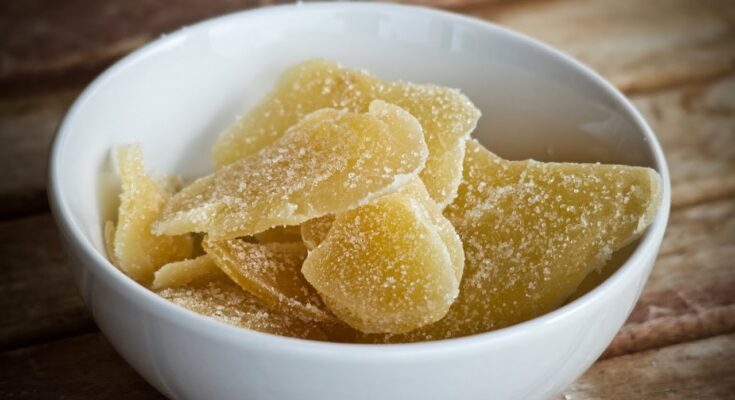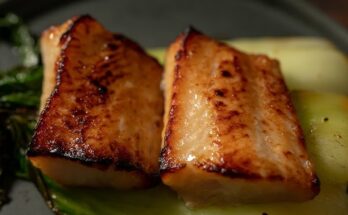Candied Ginger Recipe: Ever bit into something spicy-sweet that instantly lit up your taste buds? That zingy, sugary bite was likely candied ginger—a treat that combines the heat of fresh ginger root with the mellow sweetness of sugar. Whether you’re nibbling it for its health benefits, using it to top a dessert, or just need a snack with a punch, candied ginger is an old-school remedy and a modern kitchen favorite rolled into one.
But why buy a tiny overpriced package from the store when you can make your own batch at home? Homemade candied ginger is fresher, cheaper, and incredibly easy to make. Plus, you get total control over how sweet, spicy, or soft you want it. And let’s be real—nothing beats that homemade touch when gifting or entertaining.
So, if you’re ready to turn humble ginger root into golden, chewy candy, keep reading. We’re diving into every spicy-sweet detail, from ingredients to the final sugar-dusted finish.
Health Benefits of Ginger
Ginger isn’t just a tasty spice—it’s a medicinal powerhouse that’s been used in herbal traditions for centuries. When you make candied ginger, you’re not just creating a delicious snack, you’re harnessing the natural healing properties of this incredible root.
Here’s why ginger deserves a spot in your kitchen (and your life):
- Soothes nausea and motion sickness: Ginger has been used to settle upset stomachs for ages. It’s particularly good for travel sickness or morning nausea.
- Aids digestion: It helps stimulate saliva and bile production, making it a great after-meal treat.
- Anti-inflammatory properties: Ginger contains compounds like gingerol, which have anti-inflammatory and antioxidant effects.
- Boosts immunity: It can help you fight off colds and infections with its warming and immune-boosting qualities.
- May relieve menstrual pain: Several studies have shown ginger to be effective in reducing the pain associated with menstruation.
So, while candied ginger is a sweet treat, it’s one that comes with a bonus of well-being.
Culinary Uses of Candied Ginger
Candied ginger is a versatile little gem that can jazz up more dishes than you might think. Don’t relegate it to a dusty corner of your spice cabinet—let it shine!
Here are some creative ways to use your homemade candied ginger:
- Baking: Toss it into scones, cookies, muffins, or fruit cakes. It adds that perfect zing.
- Cooking: Add it to stir-fries, curries, or glazes for a surprising hint of sweetness and spice.
- Snacking: Just pop a piece in your mouth when you need a sweet-spicy kick.
- Toppings: Sprinkle over oatmeal, yogurt, or even ice cream.
- Cocktails and Teas: Muddle it into drinks, or stir a piece into your hot tea for added warmth.
And here’s a fun idea—jar it up and gift it. Homemade candied ginger makes for a thoughtful and unique DIY present, especially during the holidays.
Ingredients You’ll Need
Alright, before we dive into the process, let’s talk about what goes into candied ginger. Spoiler: It’s ridiculously simple. You only need three core ingredients—and maybe a couple of optional ones if you’re feeling fancy.
Here’s your basic shopping list:
- 1 pound (450g) fresh ginger root – Choose firm, smooth, juicy pieces.
- 5 cups of water – For boiling and simmering.
- 2½ cups granulated sugar – Half for the syrup, half for coating.
Optional ingredients for flavor boost:
- 1 tsp lemon juice or zest – Adds brightness and complements the ginger heat.
- 1 tsp vanilla extract – Gives a rounder flavor with sweet depth.
- Cinnamon stick or star anise – Adds a warm, spicy undertone.
You can totally make it with just ginger, sugar, and water. But feel free to experiment with flavors if you want to level up your batch.
Choosing the Best Ginger
The secret to great candied ginger starts with the ginger itself. Not all roots are created equal—so here’s what to look for when picking the perfect piece.
Go for:
- Firm, plump roots – These are fresher and juicier.
- Smooth skin – Fewer wrinkles = younger ginger = less fibrous.
- Light tan color – Avoid dark spots or mold.
If you can, avoid old or dried-out ginger—it’s too stringy and woody for candy-making.
Storing before use:
- Fridge storage: Wrap it in paper towel and place in a zip-lock bag. It’ll last 3–4 weeks.
- Freezer storage: You can freeze whole ginger. Just peel before using and slice while still slightly frozen.
Freshness really does matter, especially when the ginger is the star of the show.
Tools and Equipment Needed
Making candied ginger doesn’t require any fancy gadgets, but having the right tools will definitely make the job easier and faster.
Here’s what you’ll need:
- Peeler or spoon – To peel the ginger skin. A spoon works best for curves and knobby parts.
- Sharp knife or mandoline – For slicing evenly. Consistent thickness is key!
- Medium saucepan or pot – You’ll need this for boiling and simmering.
- Slotted spoon – For removing the ginger pieces from syrup.
- Cooling rack or baking sheet with parchment paper – To dry the ginger after candying.
- Airtight jar or container – For storing your finished product.
Optional but helpful: a kitchen scale for precise measurement, especially if you’re doubling or halving the recipe.
Step-by-Step Guide to Making Candied Ginger
Let’s get down to the juicy part: actually making the candied ginger. Don’t worry—it’s easier than baking cookies and way more forgiving.
Step 1: Peel the Ginger
Start with fresh, firm ginger roots. Use a spoon’s edge to scrape off the thin skin—it’s quicker and wastes less than a knife or peeler.
Step 2: Slice the Ginger Evenly
Cut the peeled ginger into thin, uniform slices—about ⅛ inch thick. Consistent slices ensure even cooking and a perfect chewy texture.
Step 3: Boil Ginger to Soften
Place the slices in a saucepan, cover with water, and bring to a boil. Reduce heat and simmer for 30–40 minutes until the ginger turns tender. Drain, saving a bit of the liquid if you want to reuse it for tea.
Step 4: Simmer in Sugar Syrup
In the same pan, combine equal parts sugar and water. Add the ginger slices and simmer until the syrup thickens and coats them, about 20 minutes.
Step 5: Dry and Coat in Sugar
Remove the ginger pieces and lay them on parchment paper to dry slightly, then toss in granulated sugar. Once fully dry, store in an airtight jar—sweet, spicy, and perfect for snacking or baking!
Pro Tips for Perfect Candied Ginger
Even though the process is simple, these expert tips can help elevate your candied ginger to the next level:
1. Thickness matters
- Thinner slices = crispier texture
- Thicker slices = chewier texture
Choose based on personal preference, but always keep slices even.
2. Stir often
When simmering the ginger in syrup, stir gently every few minutes to prevent sticking and scorching.
3. Don’t toss the syrup
Save that ginger-infused syrup—it’s liquid gold (we’ll show you how to use it in a bit).
4. Use a drying rack
A wire cooling rack ensures the ginger dries evenly from all sides. If using parchment paper, flip the slices halfway through drying.
5. Store properly
Once dried, keep your candied ginger in an airtight jar in a cool, dry place. It’ll stay fresh for weeks, even months if stored correctly.
These little tweaks make a big difference when you’re aiming for that perfect, snack-worthy batch.
How to Store Candied Ginger
Proper storage is key to keeping your candied ginger fresh, chewy, and flavorful.
Short-Term Storage (1–2 weeks):
- Store in an airtight glass jar or container.
- Keep in a cool, dry spot—like a pantry.
- Toss a few grains of uncooked rice in the container to absorb moisture (like you do with salt).
Long-Term Storage (1–2 months or more):
- Refrigerate in an airtight container.
- For even longer storage, freeze the pieces in a zip-lock bag. They’ll keep for up to 6 months and thaw quickly at room temp.
Bonus Tip:
Label the date on your jar so you know how fresh it is. Homemade candies don’t have preservatives, so freshness counts!
Flavor Variations
Once you’ve nailed the basic recipe, the fun really begins. Here are some ways to remix your candied ginger and make it uniquely yours:
1. Spicy Ginger
- Leave the skin on for extra bite.
- Add a pinch of cayenne or black pepper to the syrup.
2. Citrus Zest
- Add strips of lemon, orange, or lime zest to the pot while simmering.
- The citrus oils complement ginger beautifully and add a bright twist.
3. Vanilla & Cinnamon
- A teaspoon of vanilla extract in the syrup makes the ginger smoother and rounder in flavor.
- Toss in a cinnamon stick or a few cloves during the candying stage for a warm, spiced vibe.
Feel free to get creative—ginger is a surprisingly flexible base for flavor pairings.
What to Do with the Leftover Syrup
Don’t even think about pouring that syrup down the drain. It’s sweet, spicy, and absolutely usable.
Here’s how to repurpose your leftover ginger syrup:
1. Ginger Tea
- Add a tablespoon to hot water or green tea for an instant, cozy ginger tea.
2. Cocktails
- Stir into whiskey, gin, or rum cocktails. It’s especially good in a Moscow Mule or Hot Toddy.
3. Baking Glaze
- Brush it on cakes, cookies, or scones as a sweet-spicy glaze.
4. Pancake Syrup
- Use it just like maple syrup on pancakes or waffles for a gingery breakfast.
Store the syrup in a small jar in the fridge—it’ll last for several weeks.
Common Mistakes to Avoid
Even simple recipes have their pitfalls. Here are the most common candied ginger slip-ups—and how to dodge them:
1. Using old, woody ginger
- Result: chewy, fibrous candy that’s hard to eat.
- Fix: Always go for fresh, tender ginger with smooth skin.
2. Overcooking in syrup
- Result: caramelized or burnt flavor.
- Fix: Keep the heat low and stir often. Don’t rush!
3. Skipping the drying step
- Result: sticky, clumped-up pieces that won’t store well.
- Fix: Let your ginger dry fully before storing or it may mold.
4. Storing warm ginger
- Result: condensation = soggy = bad.
- Fix: Let your candy cool completely before sealing it up.
Avoid these, and you’ll be well on your way to candy perfection.
Nutritional Facts of Candied Ginger
Now, let’s talk numbers. Candied ginger might be sweet and spicy, but it’s still candy—so it’s important to know what you’re putting in your body.
Here’s a breakdown of candied ginger nutrition per 1-ounce (28g) serving:
| Nutrient | Amount |
|---|---|
| Calories | ~100-130 |
| Total Carbohydrates | ~30-35g |
| Sugar | ~25-30g |
| Dietary Fiber | ~1g |
| Protein | ~0g |
| Fat | 0g |
| Sodium | 0mg |
| Iron | 0.2mg (1% DV) |
Health Considerations:
- High in sugar – While ginger is naturally healthy, candied ginger is essentially cooked in and coated with sugar. Eat in moderation, especially if you’re watching your sugar intake.
- Vegan and gluten-free – A great natural snack for those with dietary restrictions.
- Low fat and cholesterol-free – Bonus if you’re counting fats or following a heart-healthy diet.
Although it shouldn’t be consumed in large amounts, candied ginger is a better alternative to many commercial candies—thanks to its real ingredients and natural benefits.
FAQs Candied Ginger Recipe
1. Can I reuse the ginger syrup more than once?
Yes! You can use the leftover syrup several times—for tea, cocktails, or even in salad dressings. Just store it in the fridge and keep it sealed.
2. What’s the difference between candied ginger and crystallized ginger?
They’re essentially the same, but “crystallized” ginger usually refers to ginger that has been coated in sugar after candying and allowed to dry until firm. “Candied” can refer to either syrupy or sugar-coated.
3. Can I use honey instead of sugar for candying?
You can, but the texture will be softer and stickier, not crystalized. It’s delicious but harder to store.
4. Why is my candied ginger turning dark brown?
That usually means the syrup cooked too long or at too high a heat, leading to caramelization or burning. Stick to a low, steady simmer for best results.
5. Can I dehydrate candied ginger in an oven or dehydrator?
Absolutely! If you want extra chewy or dry pieces, a dehydrator or low-temp oven (around 150°F / 65°C) can help dry them faster and more thoroughly.
Conclusion
Candied ginger is more than just a kitchen project—it’s a little jar of warmth, flavor, and nostalgia. With just a few simple ingredients and a little time, you can transform a spicy root into a chewy-sweet treat that’s perfect for baking, snacking, or even gifting.
Whether you’re doing it to avoid store-bought preservatives, to experiment with natural sweets, or simply to try something new, making candied ginger at home is satisfying and surprisingly simple. Once you’ve made your first batch, don’t be surprised if you start looking for excuses to whip up another round.
Go ahead—get peeling, slicing, and simmering. That little zingy bite is waiting for you.



